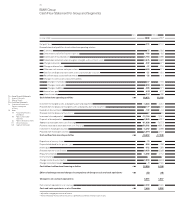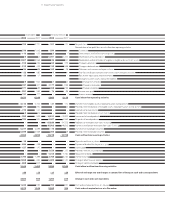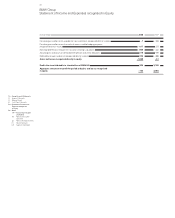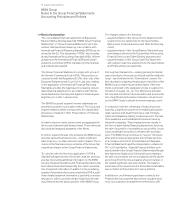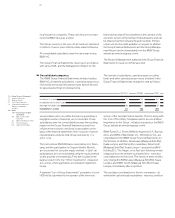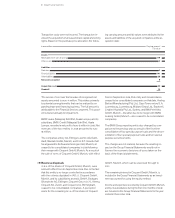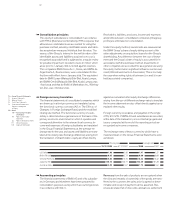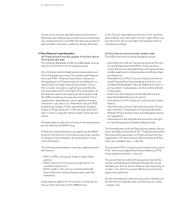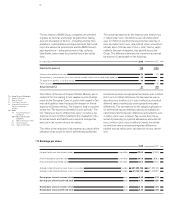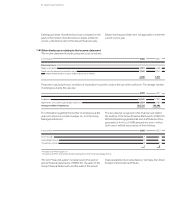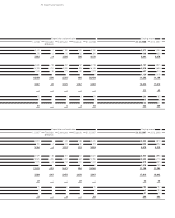BMW 2008 Annual Report Download - page 84
Download and view the complete annual report
Please find page 84 of the 2008 BMW annual report below. You can navigate through the pages in the report by either clicking on the pages listed below, or by using the keyword search tool below to find specific information within the annual report.85 Group Financial Statements
Subsequent to initial recognition, available-for-sale and
held-for-trading financial assets are measured at fair value.
When market prices are not available, the fair value of
available-for-sale financial assets is measured using appro-
priate
valuation techniques e.g. discounted cash flow
analysis based on market information available at the end
of the reporting period.
Available-for-sale assets include financial assets, securities
and investment fund shares. This category includes all
non-derivative financial assets which are not classified as
“loans and receivables” or “held-to-maturity investments”
or as items measured “at fair value through profit and loss”.
Loans and receivables which are not held for trading, held-
to-maturity financial investments and all financial assets
for which published price quotations in an active market
are not available and whose fair value cannot be determined
reliably, are measured, to the extent that they have a fixed
term, at amortised cost, using the effective interest method.
When the financial assets do not have a fixed term, they
are measured at acquisition cost.
In accordance with IAS (Financial Instruments: Recog-
nition and Measurement), assessments are made regularly
as to whether there is any objective evidence that a
finan-
cial asset or group of assets may be impaired. Impairment
losses identified after carrying out an impairment test are
recognised as an expense. Gains and losses on available-
for-sale financial assets are recognised directly in equity
until the financial asset is disposed of or is determined to
be impaired, at which time the cumulative loss previously
recognised in equity is included in net profit or loss for the
period.
With the exception of derivative financial instruments, all
receivables and other current assets relate to loans
and receivables which are not held for trading and they are
measured at amortised cost. Receivables with maturities
of over one year which bear no or a lower-than-market in-
terest rate are discounted. Appropriate impairment losses
are recognised to take account of all identifiable risks.
Receivables from sales financing comprise receivables from
retail customer, dealer and lease financing.
Impairment losses on receivables relating to the financial
services
business are recognised using a uniform method-
ology that is applied throughout the Group and meets the
requirements of IAS . This methodology results in the
recognition of impairment losses on individual assets and
groups of assets. If there is objective evidence of impair-
ment, the BMW Group recognises impairment losses on
the basis of individual assets. Within the customer retail
business, the existence of overdue balances or the
inci-
dence of similar events in the past are examples of such
objective evidence. In the event of overdue receivables,
impairment losses are always recognised individually based
on the length of period of the arrears. In the case of dealer
financing receivables, the allocation of the dealer to a cor-
responding rating category is also deemed to represent
objective evidence of impairment. If there is no objective
evidence of impairment, impairment losses are recognised
on financial assets using a portfolio approach based on
similar groups of assets. Company-specific loss proba-
bilities
and loss ratios, derived from historical data, are
used to measure impairment losses on similar groups of
assets.
The recognition of impairment losses on receivables relat-
ing to industrial business is also, as far as possible, based
on the same process applied to financial services business.
Impairment losses (write-downs and allowances) on re-
ceivables are always recorded on separate accounts and
are not written off until the corresponding receivables are
derecognised.
Items are presented as financial assets to the extent that
they relate to financing transactions.
Derivative financial instruments are only used within the
BMW Group for hedging purposes in order to reduce the
currency, interest rate and market price risks from operating
activities and related financing requirements. All derivative
financial instruments (such as interest, currency and com-
bined interest/currency swaps as well as forward currency
contracts) are measured in accordance with IAS at their
fair value, irrespective of their purpose or the intention for
which they are held. The fair values of derivative financial
instruments are measured using market information and
recognised valuation techniques. In those cases where
hedge accounting is applied, changes in fair value are rec-
ognised either in income or directly in equity under accu-
mulated other equity, depending on whether the
transac-
tions are classified as fair value hedges or cash flow hedges.
In the case of fair value hedges, the results of the fair value
measurement of the derivative financial instruments and



